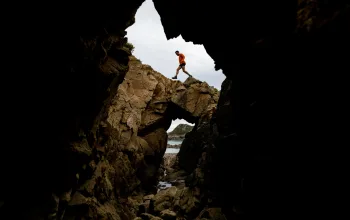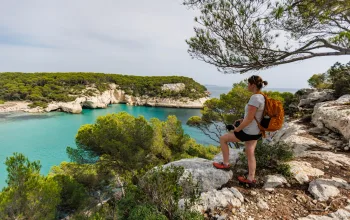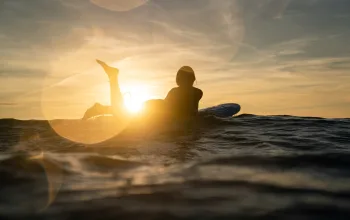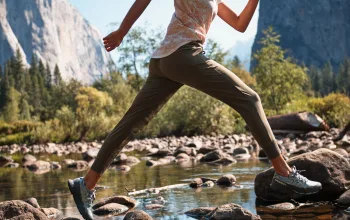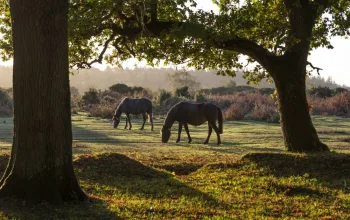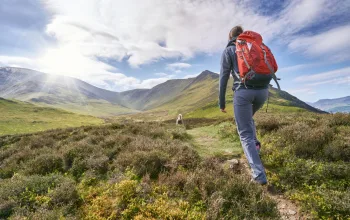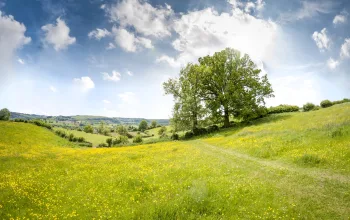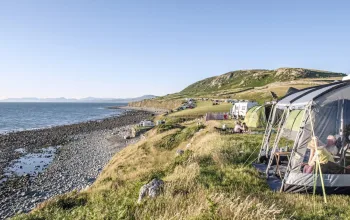‘Damn, damn, damn!’ I said, trying in vain to capture a picture with my compact camera of the black bear and her two cubs lolloping along on a tiny island in the middle of the lake. One minute they were there, seen on the LCD display screen of the camera, and a blink later they were gone, too fast for my shutter speed. The cubs climbed the tallest tree they could find, with mama bear standing guard at the base.
It was a privilege to see these seldom-observed, powerful creatures out in the wild, only ten metres away from our open, two-person canoe. It hadn’t even crossed my mind to be frightened, but my paddle-buddy, Gemma, who was valiantly steering us while I pointed the camera, was trembling with fear. ‘The mother would be on the defensive because of the cubs,’ she said, as we paddled away, ‘and they can swim!’
We were canoeing near the town of Killarney, eight hours’ drive northwest of Toronto, along the shores of Lake Huron’s Georgian Bay, one of the six ‘Great Lakes’ of Ontario. The provincial park protects the landscape and the wildlife alike. ‘On that ridge over there,’ our guide Jen pointed to a white quartz cliff, ‘there is a ban on shooting kites, to protect them, and numbers are increasing.’ A red-tipped hawk circled overhead, escorting us out of the park along Killarney Lake.
The wind picked up, funnelling between the white cliffs on either side, creating some chop on the lake. Paddling into the wind was a welcome challenge after days of still water. Pushing our bodies to make our canoe go faster, and ignoring the shoulder-burn until we had to swap to paddle on the other side, we slowly pulled ahead of the other two canoes in the girlie group. Whoever said girls aren’t competitive hasn’t been on an all-girl canoeing expedition!
Going on a trip like this can make you think long and hard about the kind of person you are when you’re in a canoe for hours with a total stranger. There were six of us, seven including the guide, all in our twenties and thirties and coming from all over Britain. Within 24 hours of meeting, we were getting to know each other rather well. Are you the one who makes it fun with your banter? Are you the bossy, domineering one? Or worse, the one who doesn’t pull their weight?
Continued...
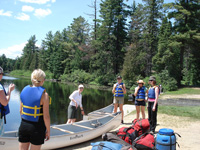 As the group bonded, giggles resounded out across the water, only silenced by the signals and hushed warnings of our guide when there was something to see – a moose grazing by the shore, a beaver carrying sticks in its mouth or the black-and-white Loon bird disappearing under the surface of the water, only to re-appear several metres away.
As the group bonded, giggles resounded out across the water, only silenced by the signals and hushed warnings of our guide when there was something to see – a moose grazing by the shore, a beaver carrying sticks in its mouth or the black-and-white Loon bird disappearing under the surface of the water, only to re-appear several metres away.
In the interior of the Algonquin Provincial Park, five hours’ drive east of Killarney, we were not only canoeing from lake to lake but also camping. Between lakes, there was portage, which means carrying your canoe upside down on your head, by means of a yoke across your shoulders, and all of your camping gear, over a small path to the next lake. Often the portage turned into a mad scramble to get across to the other side, before your shoulders gave in or the mozzies ate you alive.
Algonquin was once home to First Nations people, indigenous Canadians who used canoes made of wood and sealed bark as a means of transport from the early 1600s. As our guide pointed out at the visitors’ centre, there are 2,500 lakes in the park, which is the size of Wales, yet seemed dwarfed by the rest of Ontario on the map. This might seem obvious, but the scale of everything in Canada is just so much bigger, and the landscapes more expansive than they are in Europe.
We camped for a few nights on an island in the middle of Pen Lake, which had the perfect platform to launch yourself off for a swim, and a ready-made ring of stones for a campfire. There was also a compost toilet in a wooden shack further back from the camp area. Food, and the campfire, were the focal points of our evenings, as we relaxed after paddling for between five and seven hours a day. Amanda, our guide, was motherly in her attentions – cooking us carrot cake, rhubarb crumble and loads of nutritious food to keep up our energy.
In 1908, the first summer camp in North America was held in Algonquin on Cache Lake to introduce young girls to
the virtues of hard work, teamwork, and respect for the environment. In time-honoured style, we pitched tents, swapped stories and roasted marshmallows over the fire. Amanda produced a packet of sweet crackers and milk chocolate from her many supplies, and showed us how to make ‘S’mores’ – the traditional summer camp food concoction of melted marshmallow and chocolate in a cracker sandwich.
Continued...
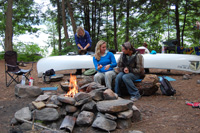 Amanda pointed out the hiccupping sound of bullfrogs, firebugs glowing in the trees, and the high-pitched squawks of the bald-headed eagle. ‘In all the films, they use a hawk’s cry because the bald-headed eagle’s sounds a bit pathetic,’ Amanda revealed, as we watched the eagle being chased by a raven, which is not the behaviour you would expect from the emblematic bird.
Amanda pointed out the hiccupping sound of bullfrogs, firebugs glowing in the trees, and the high-pitched squawks of the bald-headed eagle. ‘In all the films, they use a hawk’s cry because the bald-headed eagle’s sounds a bit pathetic,’ Amanda revealed, as we watched the eagle being chased by a raven, which is not the behaviour you would expect from the emblematic bird.
Later, after gossiping ourselves to sleep, there was a squawk of a different kind, as one of our group had got lost on a trip to the compost-loo. Even with a head-torch she had become disorientated – the trees all look the same in the dark – and had a bit of a Blair Witch moment.
The next morning we woke up at the crack of dawn, so we could experience canoeing as the sun came up. Unfortunately, the skies were grey, but it was still worth it for the feeling of adventure as our oars created furrows in the still, misty waters.
Trip Details
Getting there
Flights from London Gatwick to Toronto start from about £300 return
Accommodation
Christine stayed in a cabin at Killarney Mountain Lodge (killarney.com).
Activities
She took a four-day trip to Algonguin with Call of the Wild (callofthewild.ca). It costs £216 per person, including equipment, meals, park permits and the guide.
Canoeing in Killarney, including packed lunch, equipment hire, transport and a guide, costs £40 per person per day. Bookings through Killarney Mountain Lodge.
More info
ontariotravel.net


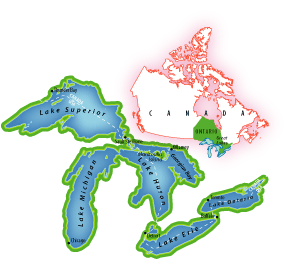 Go wild in the Great Lakes...
Go wild in the Great Lakes...
